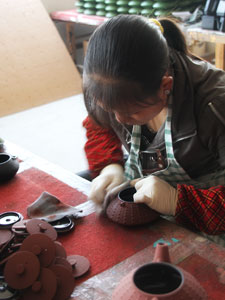Yixing Teapots 101





Yixing teapots are not just teapots, they're exceptional works of Chinese art. Dating back centuries, these teapots enhance the tea-drinking experience not only with their functionality, but with their aesthetic appeal.
Yixing (pronounced ee-shing) teapots are a Chinese tradition. Yixing, a city in the Jiangsu province in China, is known for the unique purple or red clay (their other name, zisha, means "purple clay") native only to this region. As was the case with porcelain and even tea itself, the manufacture of Yixing teapots was a long-held secret in China. While the secret of China's porcelain was eventually uncovered and porcelain became mass-produced and available to everyone, the tradition of the Yixing teapots remained relatively secret and production remained on an individual basis. While the purple clay was used to make many different things, Yixing eventually became famous for its masterfully crafted, notoriously tiny teapots. While the significance of the teapots is of no debate, the first appearance of them is: some sources claim they appeared as early as during China's Song dynasty (960-1279), others say during the Ming dynasty (1368-1644). What is clear, however, is that the popularity of the teapots began sometime in the 1500s.
As their popularity increased, the creation of the teapots became considered a true art form. Yixings were all handmade and intricately detailed with designs, pictures, or lettering. While small, their shapes could vary greatly and be completely unique. They were fired unglazed and were most commonly earthen colors, such as brown, purple, and red, but colors like blue and yellow became possible after the addition of minerals to the clay. Like other works of art, they were often signed or inscribed by their producer, which naturally could increase their demand. For all of these reasons, they became highly prized and could be quite expensive. Their unusual patterns and etchings combined to make them exquisite collectables in addition to being important pieces of teaware. As a testament to their beauty, collections of Yixing teapots are featured exhibits at museums, such as at the Phoenix Art Museum in Arizona, and the American Museum of Ceramic Art in Pomona, California. There is even an online exhibit at China Online Museum where you can view examples of the varied, meticulous, and artful teapots.
Despite being works of art, Yixing teapots are actually intended for use in brewing and serving tea. But what makes them so special that some tea experts consider them the ideal way to steep tea? Simple: with repeated and prolonged use, the teapots will become seasoned (like the way cast-iron skillets and griddles can become seasoned), which is said to enhance the tea-drinking experience. As the porous clay of the teapot absorbs the essential oils released by the tea leaves during steeping, a patina forms on the inside of the teapot. Dedicating one teapot to one flavor allows the seasoning to fully develop, as the teapot will not be affected by the brewing of different types of tea. Thus, to properly season a Yixing, you should devote only one flavor of tea to it (traditionally, oolongs are brewed in Yixings, but any flavor or type will do nicely). It is said that eventually, a well-seasoned Yixing won't even need tea leaves: just add hot water and the tea oils that have accumulated over the years in the pot will be extracted! I don't know if that's true, but it certainly is a great thought and I can't wait to try it one day.
Care for the teapots is simple, but precise. After use, they should be allowed to air dry. They should never be cleaned with soapit would ruin the seasoning that has accumulated. Only hot water or even more tea should be used when cleaning.
To this day, Yixing teapots are highly prized and handmade in Yixing. Adagio offers three different types, and all are handmade exclusively for Adagio. Each teapotthe Harbin, Dalian, and Zibois named for a Chinese city and is formed from the purple clay Yixing is famous for. Because Yixing teapots are sized for personal use and are thus relatively small (it is said that people used to drink their tea straight from the spout of their Yixing!), Adagio's teapots have 6, 8, and 10 oz capacities, respectively. So be prepared: if you order a Yixing expect an adorable, personal-sized conversation piece of a teapot, not a teapot fit to serve 10 guests at your next dinner party.
Personally, I greatly enjoy the tea brewed in my Yixing. I've been building up the patina on it for a little while now, and although I don't think the teapot is quite ready to brew tea sans leaves, the tea definitely has a wonderful flavor that I attribute, in part, to the pot. Maybe it is the mystical purple clay, maybe it's the placebo effect. Either way, if you typically enjoy one flavor of tea on a regular basis, brewing it in a Yixing is a great way to enhance your enjoyment. Even if you only occasionally enjoy tea, Yixings are a pleasant and pretty addition to any table.
